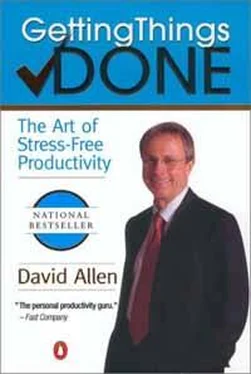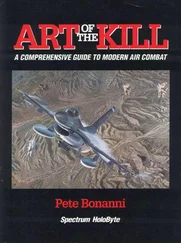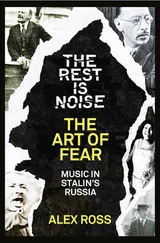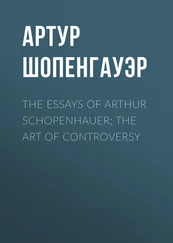The Process: Managing Action
You can train yourself, almost like an athlete, to be faster, more responsive, more proactive, and more focused in knowledge work. You can think more effectively and manage the results with more ease and control. You can minimize the loose ends across the whole spectrum of your work life and personal life and get a lot more done with less effort. And you can make front-end decision-making about all the "stuff" you collect and create standard operating procedure for living and working in this new millennium.
Before you can achieve any of that, though, you'll need to get in the habit of keeping nothing on your mind. And the way to do that, as we've seen, is not by managing time, managing information, or managing priorities. After all:
• you don't manage five minutes and wind up with six;
• you don't manage information overload—otherwise you'd walk into a library and die, or the first time you connected to the Web, or even opened a phone book, you'd blow up; and
• you don't manage priorities—you have them.
Instead, the key to managing all of your "stuff" is managing your actions.
Managing Action Is the Prime Challenge
What you do with your time, what you do with information,and what you do with your body and your focus relative to your priorities—those are the real options to which you must allocate your limited resources. The real issue is how to make appropriate choices about what to do at any point in time. The real issue is how we manage actions.
That may sound obvious. However, it might amaze you to discover how many next actions for how many projects and commitments remain undetermined by most people. It's extremely difficult to manage actions you haven't identified or decided on. Most people have dozens of things that they need to do to make progress on many fronts, but they don't yet know what they are. And the common complaint that "I don't have time to ____ " (fill in the blank) is understandable because many projects seem overwhelming—and are overwhelming because you can't do a project at all! You can only do an action related to it. Many actions require only a minute or two, in the appropriate context, to move a project forward.
The beginning is half of every action.
- Greek
In training and coaching thousands of professionals, I have found that lack of time is not the major issue for them (though they themselves may think it is); the real problem is a lack of clarity and definition about what a project really is, and what the associated next-action steps required are. Clarifying things on the front end, when they first appear on the radar, rather than on the back end, after trouble has developed, allows people to reap the benefits of managing action.
Things rarely get stuck because of lack of time. They get stuck because the doing of them has not been defined.
The Value of a Bottom-Up Approach
I have discovered over the years the practical value of working on personal productivity improvement from the bottom up, starting with the most mundane, ground-floor level of current activity and commitments. Intellectually, the most appropriate way ought to be to work from the top down, first uncovering personal and corporate missions, then defining critical objectives, and finally focusing on the details of implementation. The trouble is, however, that most people are so embroiled in commitments on a day-to-day level that their ability to focus successfully on the larger horizon is seriously impaired. Consequently, a bottom-up approach is usually more effective.
Getting current on and in control of what's in your in-basket and on your mind right now, and incorporating practices that can help you stay that way, will provide the best means of broadening your horizons. A creative, buoyant energy will be unleashed that will better support your focus on new heights, and your confidence will increase to handle what that creativity produces. An immediate sense of freedom, release, and inspiration naturally comes to people who roll up their sleeves and implement this process.
You'll be better equipped to undertake higher-focused thinking when your tools for handling the resulting actions for implementation are part of your ongoing operational style. There are more meaningful things to think about than your in-basket, but if your management of that level is not as efficient as it could be, it's like trying to swim in baggy clothing.
Vision is not enough; it must be combined with venture. It is not enough to stare up the steps; we must step up the stairs.
— Vaclav Havel
Many executives I have worked with during the day to clear the decks of their mundane "stuff" have spent the following evening having a stream of ideas and visions about their company and their future. This happens as an automatic consequence of unsticking their workflow.
Horizontal and Vertical Action Management
You need to control commitments, projects, and actions in two ways—horizontally and vertically. "Horizontal" control maintains coherence across all the activities in which you are involved.Imagine your psyche constantly scanning your environment like police radar; it may land on any of a thousand different items that invite or demand your attention during any twenty-four-hour period: the drugstore, the housekeeper, your aunt Martha, the strategic plan, lunch, a wilting plant in the office, an upset customer, shoes that need shining. You have to buy stamps, deposit that check, make the hotel reservation, cancel a staff meeting, see a movie tonight. You might be surprised at the volume of things you actually think about and have to deal with just in one day. You need a good system that can keep track of as many of them as possible, supply required information about them on demand, and allow you to shift your focus from one thing to the next quickly and easily.
"Vertical" control, in contrast, manages thinking up and down the track of individual topics and projects. For example, your inner "police radar" lands on your next vacation as you and your spouse talk about it over dinner—where and when you'll go, what you'll do, how to prepare for the trip, and so on. Or you and your boss need to make some decisions about the new depart-mental reorganization you're about to launch. Or you just need to get your thinking up to date on the customer you're about to call. This is "project planning" in the broad sense. It's focusing in on a single endeavor, situation, or person and fleshing out whatever ideas, details, priorities, and sequences of events may be required for you to handle it, at least for the moment.
The goal for managing horizontally and vertically is the same: to get things off your mind and get things done. Appropriate action management lets you feel comfortable and in control as you move through your broad spectrum of work and life, while appropriate project focusing gets you clear about and on track with the specifics needed.
The Major Change: Getting It All Out of Your Head
There is no real way to achieve the kind of relaxed control I'm promising if you keep things only in your head. As you'll discover, the individual behaviors described in this book are things you're already doing. The big difference between what I do and what others do is that I capture and organize 100 percent of my "stuff" in and with objective tools at hand, not in my mind. And that applies to everything —little or big, personal or professional, urgent or not. Everything.
There is usually an inverse proportion between how much something is on your mind and how much it's getting done.
Читать дальше











